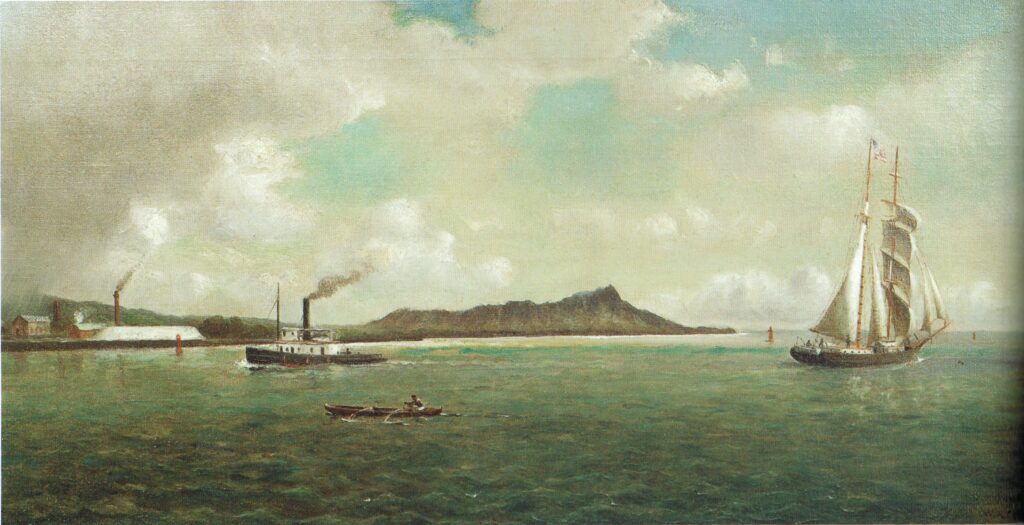St. Anthony of Padua Church in Wailuku, Maui, Hawaii was established by the Fathers of the Order of the Sacred Heart of Jesus, whose arrival from France on July 7, 1827, marked the start of the Catholic Mission in Hawaii.
Saint Anthony of Padua was born in Lisbon, Portugal on August 15, 1195. He came from a wealthy family who did not support his desire to enter into religious life. He became a Franciscan friar in 1221 and joined the order in hopes of spreading God’s Word to the people of Morocco in spite of facing a possible martyr’s death.
Instead, he became a respected teacher and orator who gained fame for his miracles. He was a holy man who had apparitions of the Infant Jesus and of St. Francis of Assisi. This is why he is often depicted holding the baby Jesus in his arms.
He is a patron saint of the poor and oppressed and is often invoked as a finder of “lost articles and missing persons”. He died in Padua, Italy on June 13, 1231, at the age of 36 and was canonized a saint less than a year later. He was declared a Doctor of the Church by Pope Pius XII in 1946.
After more than two decades of political and social upheaval as well as religious persecution, the first High Mass was celebrated at St. Anthony in Wailuku on July 13, 1848 in a thatched structure.
Beginning in 1848, St. Anthony School grew from a one-room schoolhouse erected by the Sacred Heart’s Fathers on the grounds of St. Anthony Church.
In 1854, St. Anthony was built in wood to replace the native church. It was reported that 6000 baptisms were recorded on Maui that year.
In 1858-59, King Kamehameha IV deeded 16 acres of land in Wailuku to Bishop Louis Maigret and on May 3, 1873, under the direction of Father Lenore Fouesnel, SS.CC., the third church (now in stone) that took six years to build, was blessed.
It is said that it was at this event that Father Damien de Veuster SS.CC, made his commitment to go to Kalaupapa Leprosy Settlement and thus, began his remarkable journey to sainthood.
Founded in 1873, St. Anthony Grade School is a Catholic Parish co-educational school offering a Kindergarten to Fifth Grade education.
The Brothers of Mary had founded the Wailuku School for Boys in 1883 at the invitation of the Sacred Heart’s Fathers and staffed what later would become St. Anthony Junior-Senior High School.
The church building continued to be improved and expanded over the years. In 1919, it was remodeled into a gothic style with a sanctuary, semi-rotund baptistery and bell tower. In 1940, it was enlarged on both sides under the direction of Father Bruno Bens and stood majestically as a major landmark in Wailuku for over a century.
The Sacred Hearts Fathers (SSCC), established St. Anthony parish school in 1883. On September 5, 1883, the Society of Mary (Marianists) arrived in Wailuku and initiated the beginning of their long years of service to the parish and school. The first of three Brothers opened the school September 10, 1883.
The Franciscan Sisters of Syracuse, New York, staffed the girls’ school beginning in 1884. The Maryknoll Sisters, began teaching at St. Anthony in 1928 at the request of Bishop Alencastre. Dedicated lay persons assisted in the teaching beginning September 1958.
Chaminade and Damien Hall were erected in 1925. It houses the school administrative offices as well as ten classrooms and two computer labs.
Maryknoll Hall was built in 1940 and encompasses eight classrooms, an art studio, and counseling offices. Marian Hall, the cafeteria, was built in 1959.
The Bishop Sweeny Memorial Library was built in 1965. The library was renovated in 2002 and now houses the Harry C. and Nee Chang Wong Media Center. The science facility was completed in 1967. The science labs were completely renovated and rededicated as the E. L. Weigand Science Building in 2005. (St Anthony School)
In 1968 the school became coeducational and the junior high was added in 1971. Today, St. Anthony School is the only Catholic School on the island of Maui that ranges from Preschool to High School.
In 1976, the Society of Mary (Marianists) assumed leadership of St. Anthony Parish from the Sacred Heart Fathers. A year later, on November 1, 1977, the historic church was destroyed by an early morning fire set by an arsonist.
The present, modern structure was dedicated on June 13, 1980, St. Anthony’s feast day, just three years after the tragic fire. (St Anthony Maui)
It is a diocesan, coeducational institution under the Bishop of Honolulu, governed by the St. Anthony School Board, and sponsored by the members of the Society of Mary (Marianists).






















































